AI-Driven Irrigation: Smarter Water Use
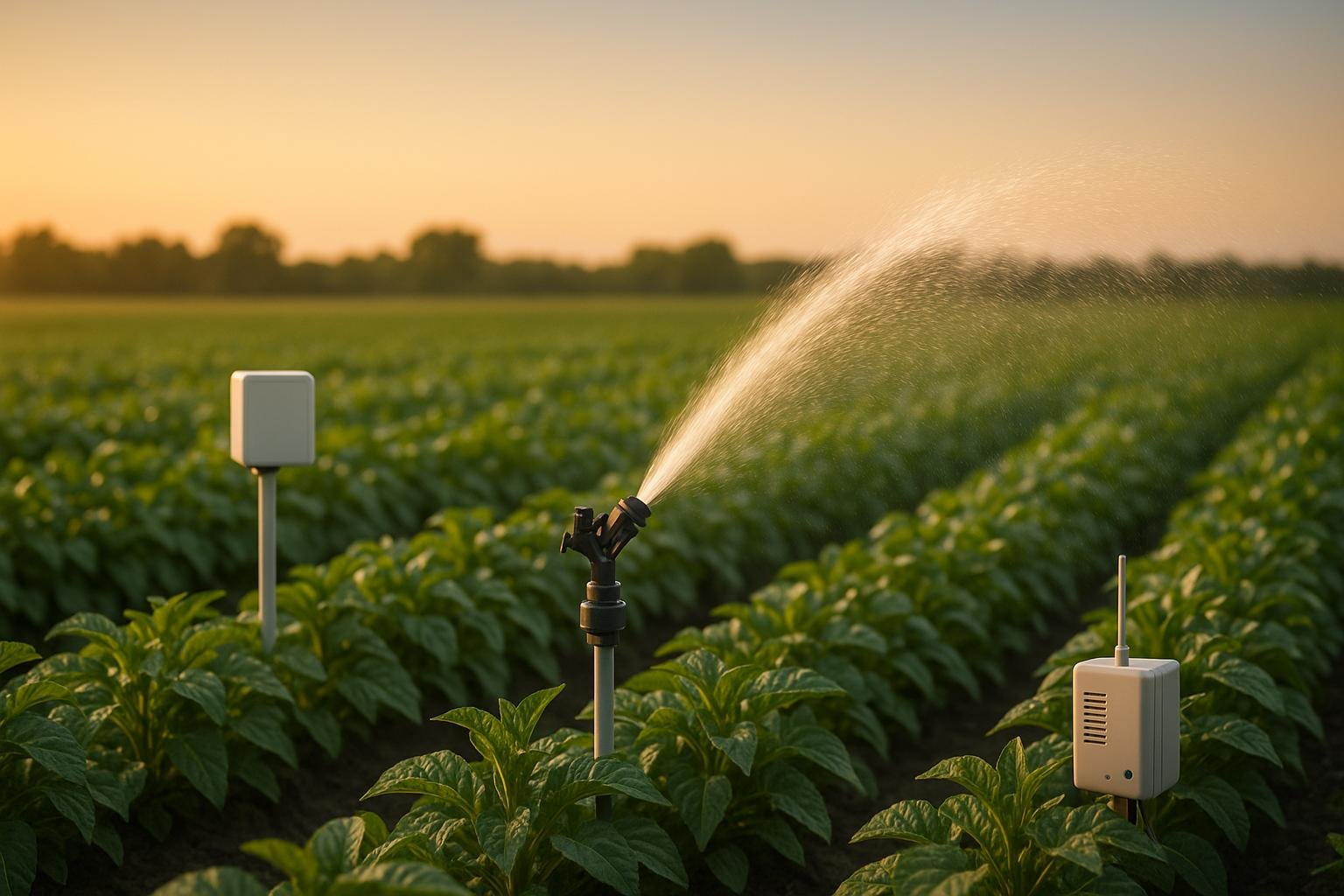
AI-driven irrigation systems are transforming how water is managed in gardens, farms, and landscapes. By using artificial intelligence, machine learning, and smart sensors, these systems optimize water delivery, reduce waste, and improve plant health. Here's what you need to know:
- Water Efficiency: AI systems cut water use by 30–50% and improve crop yields by 20–30%.
- Cost Savings: Lower water bills, reduced labor, and minimized fertilizer waste.
- Core Features: Real-time data from soil moisture sensors, weather forecasts, and IoT devices ensures precise watering.
- Environmental Impact: Reduces water waste, energy use, and chemical contamination.
- Implementation: Systems can be tailored to gardens with tools like soil sensors, drip irrigation, and AI controllers.
Switching to AI-powered irrigation offers measurable benefits, including lower costs, healthier plants, and smarter water management.
The Future of Irrigation How AI Saves Water & Grows Crops

Core Technologies in AI-Driven Irrigation
AI-driven irrigation systems bring together sensors, processing units, automated controls, and communication networks to deliver precise, real-time water management solutions [7].
Key Components of AI Irrigation Systems
At the heart of AI irrigation systems is data collection, made possible by a variety of sensors. Soil moisture sensors play a crucial role, providing real-time data on moisture levels, temperature, and other environmental conditions in the root zone [5]. Similarly, weather stations gather vital information on rainfall, humidity, and temperature, helping the system adjust irrigation schedules based on current and forecasted weather conditions [5]. For example, if rain is expected, the system can reduce or skip irrigation cycles to conserve water.
| Component | Function |
|---|---|
| Soil Moisture Sensors | Provide real-time data on soil moisture, temperature, and environmental conditions [5] |
| Weather Stations | Collect data on rainfall, humidity, and temperature for informed irrigation decisions [5] |
| Data Analysis and Machine Learning | Identify patterns and predict soil moisture needs based on historical and real-time data [5] |
| Automated Irrigation Control Systems | Operate irrigation equipment like pumps and valves based on AI-driven insights [5] |
Additional tools like optical sensors evaluate light reflection to assess soil properties and crop health [9]. Meanwhile, electrochemical sensors monitor soil pH and quality, ensuring water delivery supports optimal nutrient absorption [9].
The system’s data processing unit is where AI algorithms analyze incoming sensor data and make real-time irrigation decisions. Automated controls then execute these decisions, adjusting equipment such as valves and pumps to meet the plants' needs [5].
The Role of Machine Learning and IoT
Machine learning is key to predicting irrigation requirements. By analyzing historical and real-time data, it identifies trends and makes more accurate irrigation recommendations. For instance, in Hawaii, AI-driven irrigation scheduling has reduced water consumption by up to 30% while boosting crop yields by 20% [5].
IoT devices play a central role in collecting and transmitting sensor data to processing units in real time [8]. These devices also enable remote monitoring, allowing users to adjust irrigation settings through mobile apps or web platforms [2].
The integration of IoT and machine learning creates a seamless cycle: sensors detect conditions, data is sent to the AI system, machine learning processes the information, and automated controls implement the irrigation plan. This ensures irrigation adapts continuously as conditions evolve.
"AI leverages data from various sources - such as weather forecasts, soil moisture sensors, and satellite imagery - to make intelligent irrigation decisions." - Ted Wodoslawsky, c3controls [6]
Advanced systems also incorporate satellite imagery and drone data to monitor large-scale areas. These tools can identify water stress patterns that ground-based sensors might miss. For example, an Australian farm used satellite AI analysis to spot water-stressed zones, cutting irrigation by 25% while improving crop consistency [6].
Reliable communication protocols are essential for these systems, ensuring uninterrupted data transmission even in challenging outdoor environments. Most modern setups use wireless technology to maintain connectivity across vast properties, enabling centralized control over multiple irrigation zones.
This blend of technologies not only drives water conservation but also reduces costs, laying the groundwork for a deeper exploration of the benefits of AI-powered irrigation.
Benefits of AI-Powered Irrigation Systems
By combining sensors, machine learning, and IoT, AI-powered irrigation systems have reshaped water management in gardens and landscapes. These systems go beyond just conserving water - they also help save money, improve plant health, and significantly reduce environmental harm.
Water and Cost Savings
AI-powered irrigation systems can reduce water usage by up to 50% while increasing crop yields by 30% [3]. This translates directly into lower water bills for homeowners and reduced operational costs for landscapers.
For instance, farms in Alberta cut water use by 35%, saving approximately 100,000 liters per hectare, and increased yields by 15% [11]. The Thompson family farm in Lethbridge upgraded their 15-year-old pivot system with wireless sensors and a smart controller. This allowed them to adopt climate-responsive irrigation strategies without replacing their existing infrastructure [11].
Initial costs for these systems vary widely. Soil moisture sensors range from $150 to $300, weather stations cost between $500 and $1,200, and controllers are priced at $300 to $800. Larger systems for farms can cost between $15,000 and $50,000 per quarter section [11]. While the upfront investment may seem steep, the long-term savings from reduced water bills and improved crop productivity quickly offset these costs.
AI systems also cut labor costs by automating irrigation decisions, removing the need for manual monitoring and adjustments. Additionally, they reduce fertilizer waste by ensuring nutrients are delivered at the right time, leading to healthier plants and further cost reductions.
Better Plant Health and Environmental Impact
AI-based irrigation optimizes watering with precision that traditional methods can't match. These systems use sensors to fine-tune growing conditions, reduce chemical use, and protect soil health. They can even detect early signs of plant stress or pest infestations, enabling targeted interventions with minimal chemical application.
This precision has far-reaching environmental benefits. AI systems can lower chemical usage by up to 50%, reducing the risk of environmental contamination [1]. For example, Green Thumb Farms implemented a smart irrigation system that adjusted water usage based on real-time weather and soil data. This approach significantly cut water consumption while maintaining healthy crop yields [12].
The Smart Orchard Spray Application project offers another example, where IoT-based irrigation systems achieved 14–26% water savings and improved resource efficiency [1]. These systems also support integrated pest management, reducing the need for harmful pesticides while ensuring healthy plant growth.
By applying water exactly where and when it's needed, AI-driven systems help preserve soil health. They prevent waterlogging and nutrient leaching, maintaining soil structure and encouraging the growth of beneficial microorganisms. This creates an ideal environment for plants to thrive.
AI-Driven vs Standard Irrigation Comparison
The contrast between AI-driven and traditional irrigation methods is stark, especially when it comes to efficiency and performance. The table below highlights these differences:
| Feature | Traditional Irrigation | AI-Driven Irrigation |
|---|---|---|
| Water Efficiency | 30-70% water waste due to evaporation and imprecise application [1] | 30-50% water savings through precision delivery [1] |
| Scheduling | Static schedules regardless of conditions | Dynamic response to real-time environmental data [1] |
| Crop Productivity | Baseline yields with potential stress from over/under watering | 20-30% increase in productivity [1] |
| Application Uniformity | Variable, often below 70% efficiency | Over 90% uniformity when combined with drip systems [10] |
| Labor Requirements | Manual monitoring and adjustment needed | Automated operation with minimal intervention |
| Chemical Usage | Standard application rates | Up to 50% reduction in chemical treatments [1] |
| Adaptability | Limited response to weather changes | Continuous adaptation to environmental variability [1] |
Traditional irrigation systems rely on fixed schedules that don’t adapt to changing weather, soil conditions, or plant needs. AI systems, on the other hand, continuously monitor and adjust, ensuring water is delivered exactly when and where it’s needed. This difference explains why AI systems achieve 30–50% water savings and boost crop productivity by 20–30% [1].
AI systems also excel in delivering water directly to plant root zones, minimizing losses from evaporation and runoff. In contrast, methods like furrow irrigation and sprinklers often waste large amounts of water before it even reaches the plants.
With their precision and adaptability, AI-driven irrigation systems are the clear choice for gardeners and landscapers aiming to improve efficiency, reduce costs, and lessen their environmental impact.
sbb-itb-4d6a8dd
🚀 Ready to Reinvent Your Garden?
Join thousands of homeowners who have transformed their gardens using our AI design tool. Upload one photo to explore endless possibilities.
Get your AI garden designs →Implementing AI-Driven Irrigation in Gardens
Switching from traditional watering methods to an AI-powered irrigation system might seem like a big leap, but it doesn’t have to be complicated. With the right steps, you can upgrade your garden’s water management while keeping your existing landscape intact. The process boils down to understanding how to set up the system and how it adjusts to your garden’s unique needs.
Steps for Installing AI Systems
Setting up an AI irrigation system starts with thoughtful planning and methodical execution. First, evaluate your garden’s watering needs. This means identifying different zones based on factors like plant types, sunlight exposure, and soil conditions. These details help determine where sensors should go and how water should be distributed, laying the groundwork for the system to perform optimally.
Next, map out your system’s layout. This step is crucial because it ensures everything works efficiently. Keep in mind your soil type, the layout of your garden, and the water requirements of your plants. Grouping plants with similar water needs, a method known as hydrozoning, is a smart way to maximize efficiency and minimize waste [13].
When it comes to choosing the right irrigation method, tailor it to your garden’s needs:
- Drip irrigation: Ideal for flower beds and vegetable gardens, using up to 50% less water than sprinklers [13].
- Sprinkler systems: Best for lawns and larger areas.
- Soaker hoses: Perfect for delicate plants needing gentle, consistent watering.
The installation process involves connecting sensors, controllers, and water delivery components. Start by placing soil moisture sensors at root depth in each zone - about 6–12 inches from plant stems - to get accurate readings without interference from surface water or mulch. Then, connect the system to your water source, installing a shut-off valve and pressure regulator to protect the setup. The AI controller links to your home’s Wi‑Fi, enabling it to access weather data and send performance updates.
Before letting the system take over, manually test each zone to ensure proper coverage and water pressure. This initial testing helps the system establish benchmarks for future optimization. Also, think ahead - installing extra sensor ports and irrigation lines during setup can save time and money if you expand your garden later [13].
Once installed, the system begins fine-tuning itself, adjusting in real time to your garden’s specific conditions.
Adjusting to Local Climate and Garden Needs
AI-driven irrigation systems shine when it comes to adapting to local conditions. They combine data from weather forecasts, soil sensors, and plant needs to distribute water efficiently [14]. Using machine learning, these systems analyze both historical and real-time data to create watering schedules that adjust to changing seasons and weather patterns.
IoT devices play a big role here. They gather detailed environmental data - like soil moisture, temperature, and humidity - which the AI uses to calculate the exact water needs for each zone [14]. On larger properties, remote sensing tools, including satellite data, offer additional insights into soil and plant health.
The system also customizes watering schedules based on local climate data. For instance, a vineyard in California used an AI irrigation system to cut water usage by 35% while maintaining crop quality [14]. The system adapted to the area’s Mediterranean climate by adjusting for seasonal rainfall and temperature changes.
Soil type is another factor the system learns over time. For example, clay soils, which retain moisture, require less frequent watering, while sandy soils need more frequent watering. AI systems pick up on these patterns and adjust automatically. To get the best results, consider your local water resources and soil type during setup [16].
Many systems come with user-friendly interfaces and even training materials to help you manage your setup easily [15]. They also use fuzzy logic controls to handle environmental uncertainties [1], ensuring smooth operation. Seasonal adjustments happen automatically, but it’s a good idea to review your system at the start of each growing season. Check sensor calibration and analyze water usage from the previous year to make any necessary tweaks [13].
A well-maintained AI irrigation system can cut household water use by about 15% - saving nearly 7,600 gallons of water annually [13]. That’s a win for both your wallet and the environment.
AI Tools for Water-Efficient Garden Design
AI-driven irrigation systems may handle the watering itself, but the real magic of water-efficient gardening starts with smart garden design. AI-powered garden planning tools are reshaping water conservation by analyzing local conditions and recommending plants that naturally need less water. This takes the guesswork out of designing gardens, creating spaces that thrive with minimal water use. These tools work hand-in-hand with modern irrigation systems, making the entire process more precise and efficient.
Traditional garden design often involves trial and error, which can waste water and harm plants. AI tools, on the other hand, use data on climate, soil, and plant compatibility to craft optimized garden layouts right from the beginning.
Custom Planting Plans with AIGardenPlanner
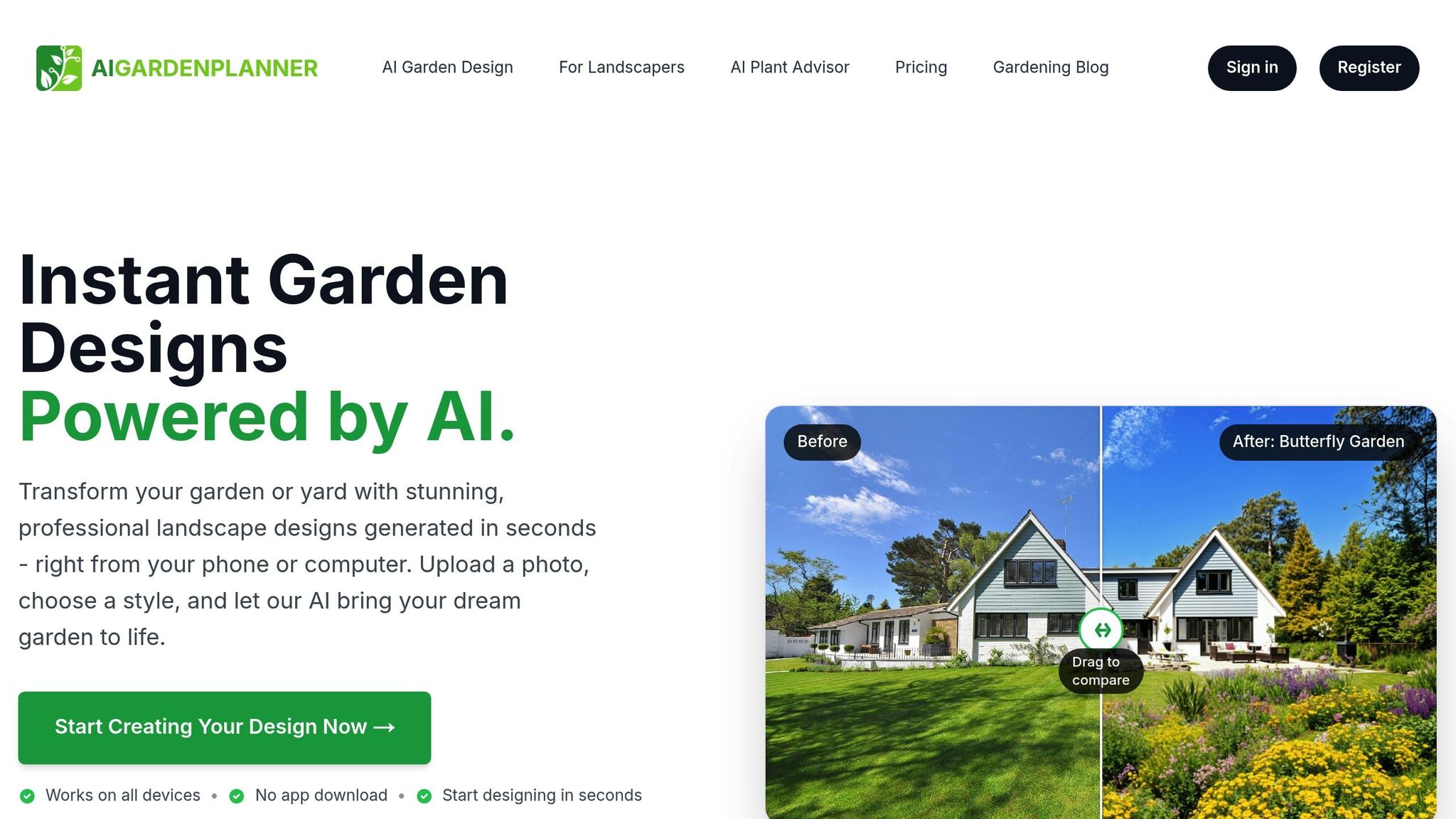
Beyond just irrigation, intelligent garden design is crucial for sustainable water use. Tools like AIGardenPlanner analyze your location, climate zone, and soil to recommend drought-resistant plants and efficient watering schedules.
The platform collects detailed information about your outdoor space, such as its size, soil type, and your plant preferences. It also evaluates factors like sunlight exposure, water needs, and the mature size of plants. Using this data, it creates thoughtful garden designs that conserve water while aligning with your local climate and resources.
For example, AIGardenPlanner doesn’t just recommend drought-tolerant plants like lavender, rosemary, and olive trees for a Mediterranean-style garden - it also calculates watering schedules based on local weather and soil conditions. By suggesting irrigation systems tailored to your garden’s unique needs, it creates a complete water management strategy.
The tool even considers plant compatibility and spacing to ensure efficient water distribution. This prevents common mistakes like planting thirsty species next to drought-tolerant ones, which can lead to overwatering or underwatering.
Professional Features for Landscapers and Gardeners
AIGardenPlanner isn’t just for home gardeners - it also includes advanced features for professionals managing larger landscapes. These tools help refine water use on a bigger scale, offering detailed growing guides, maintenance schedules, and high-resolution design downloads for seamless implementation.
One standout feature is its ability to create hydrozones, grouping plants with similar water needs. This approach streamlines irrigation, reducing waste while keeping plants healthy. For landscaping professionals, the platform simplifies complex design tasks, delivering polished results without requiring extensive technical expertise.
AIGardenPlanner also supports commercial licensing and provides priority support, making it a great choice for projects focused on water conservation. High-resolution plans can be integrated with AI-driven irrigation systems, building a cohesive strategy for efficient water use.
Another benefit is the flexibility to create custom garden styles tailored to specific conservation goals. Landscapers can develop unique, drought-resistant designs that are both functional and visually appealing. Early access to new features ensures users stay ahead with cutting-edge techniques for water-efficient gardening.
Each plant recommendation comes with a detailed care guide, including watering instructions, seasonal maintenance tips, and strategies to maximize water efficiency. These guides help ensure that water-saving gardens remain healthy and continue to conserve resources long after they’re established.
Research highlights the impact of these designs: water-efficient gardens can reduce water use by up to 80% compared to traditional lawns [17]. This underscores how thoughtful plant selection and design can significantly cut water consumption while creating beautiful, sustainable spaces.
Conclusion
AI-powered irrigation is transforming how we manage water in gardens, replacing outdated techniques with smarter, more precise systems. Studies reveal that these technologies consistently deliver impressive results, saving 30–50% of water while increasing plant productivity by 20–30% [1]. Machine learning models alone can cut water consumption by up to 40%, while AI-driven energy management reduces electricity use by 20–30% [6]. Real-world examples back up these claims - a vineyard in California, for instance, slashed its water usage by 35% without compromising crop quality [6].
"AI is revolutionizing agricultural irrigation by optimizing water use, enhancing efficiency, and improving crop yields." - Ted Wodoslawsky, c3controls [6]
But the benefits don’t stop at water savings. These systems also reduce chemical use by 50%, significantly lowering environmental harm [1]. By preventing over-irrigation and minimizing runoff, AI tools protect local water sources and promote healthier soil. This dual focus on conservation and plant health creates lasting advantages for gardeners and landscapers alike.
For gardeners, the payoff is clear: lower water bills, reduced maintenance costs, and stronger, healthier plants. Traditional watering methods can waste up to 50% of water due to inefficiencies [18]. In contrast, AI-driven systems achieve water efficiency rates of 85–95%, far outperforming the 60–70% efficiency of older methods [18]. While the upfront cost might seem high, the long-term savings and reduced need for plant replacements make it a worthwhile investment.
Pairing AI irrigation with tools like AIGardenPlanner takes garden management to the next level. This combination ensures not only precise watering but also smart plant selection, creating a cohesive, water-efficient strategy. With the U.S. market for digital water solutions expected to grow 6.5% annually, reaching $10.8 billion by 2030 [4], adopting AI irrigation is quickly becoming the norm for responsible water use.
FAQs
How do AI-powered irrigation systems adapt to different soil and weather conditions?
AI-powered irrigation systems combine sensors and smart technology to keep a close eye on essential factors like soil moisture, temperature, humidity, and weather forecasts. Using this real-time data, they calculate exactly how much water your garden needs and adjust automatically to changes, like unexpected rain or seasonal variations.
This smart watering method not only saves water but also ensures your plants stay healthy, even in tough climates. Whether your soil dries out quickly or holds onto moisture, these systems adapt to provide the perfect amount of irrigation for your garden's unique conditions.
What are the upfront costs and long-term benefits of using an AI-powered irrigation system?
The initial price tag for AI-powered irrigation systems in the U.S. can range widely, starting at $2,500 and climbing to $10,000 or more, depending on the system's size and complexity. For a medium-sized garden, you're likely looking at an average installation cost of about $10,000.
What makes these systems appealing is their ability to cut water usage by 30-50%, which translates to noticeable savings on water bills. On top of that, they can boost crop yields by 20-30%, making them a worthwhile option for both homeowners and commercial growers. While the upfront expense might feel steep, the long-term benefits - both financial and environmental - often justify the investment.
How does AI-powered irrigation promote sustainability and reduce the need for chemicals?
AI-powered irrigation systems are transforming water conservation by using real-time data to deliver just the right amount of water where it’s needed. This precise approach cuts down on waste and runoff, helping to preserve water resources and reduce contamination of nearby streams, rivers, and other water sources.
On top of that, these systems boost plant health by creating customized watering schedules. This targeted care can decrease the reliance on fertilizers and pesticides, leading to cleaner, healthier ecosystems. By fine-tuning water and chemical use, AI-driven irrigation is paving the way for more sustainable farming and gardening methods.
🎨 Visualize Your Dream Garden Today!
Transform any outdoor space into a professional landscape design in minutes. Just upload a photo, choose your style, and let our AI do the rest.
Start your garden transformation now →Related posts
Related Articles
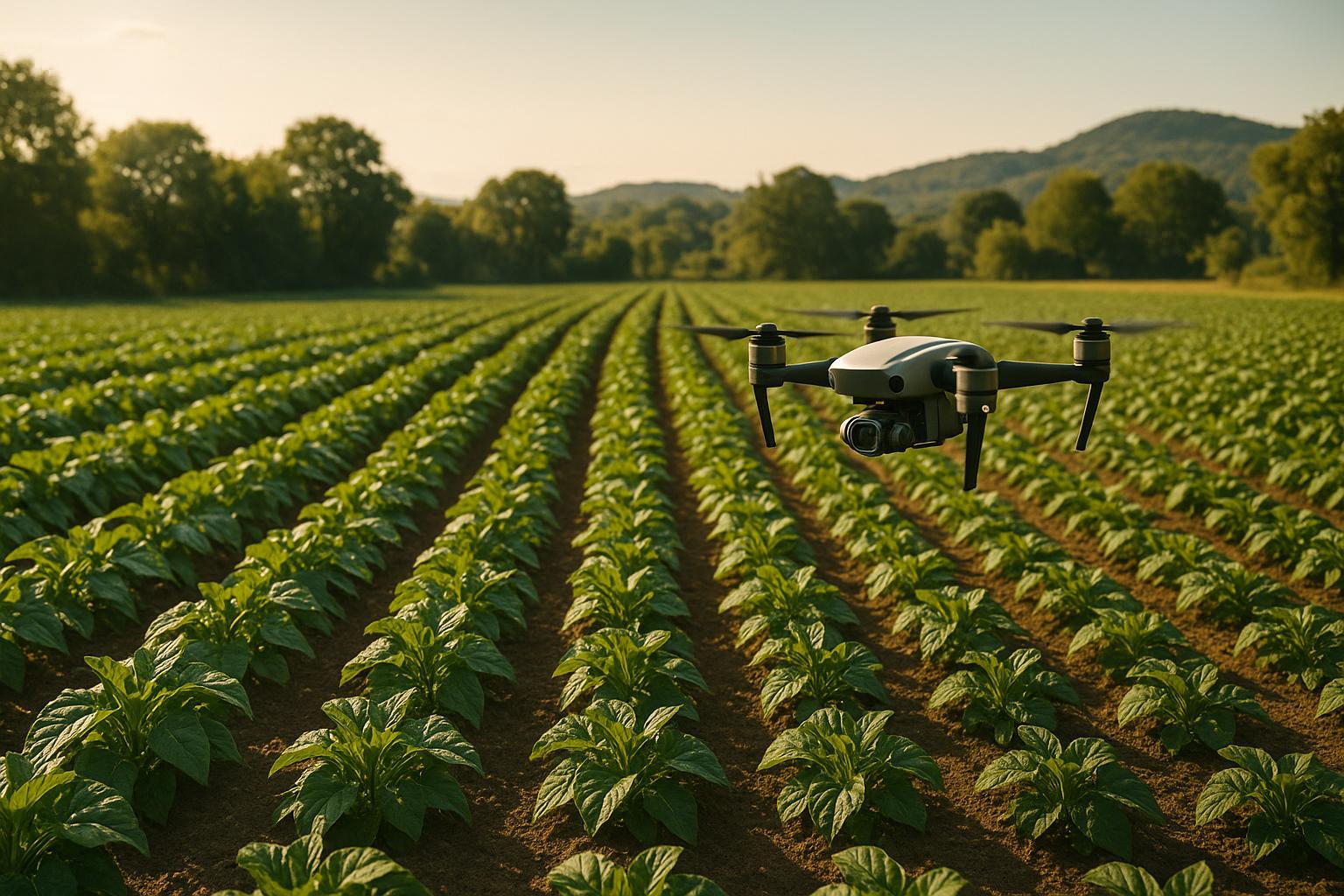
Top AI Tools for Integrated Pest Management
Explore how AI tools are revolutionizing pest management, enhancing efficiency while significantly reducing pesticide usage for sustainable agriculture.
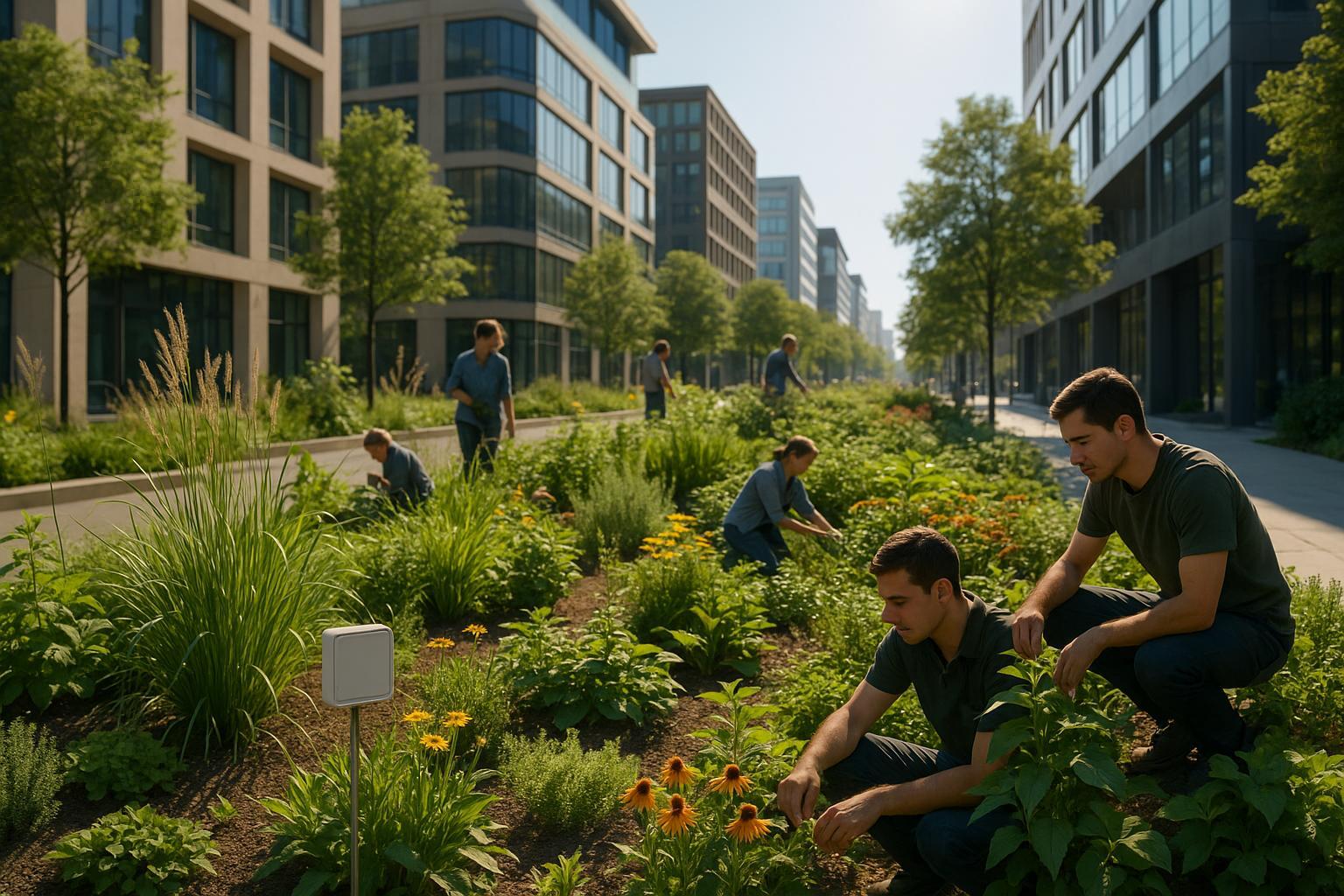
AI Climate Analysis for Urban Planting Success
AI is revolutionizing urban planting with precise climate analysis, optimizing resources, and enhancing sustainability while addressing traditional method limitations.
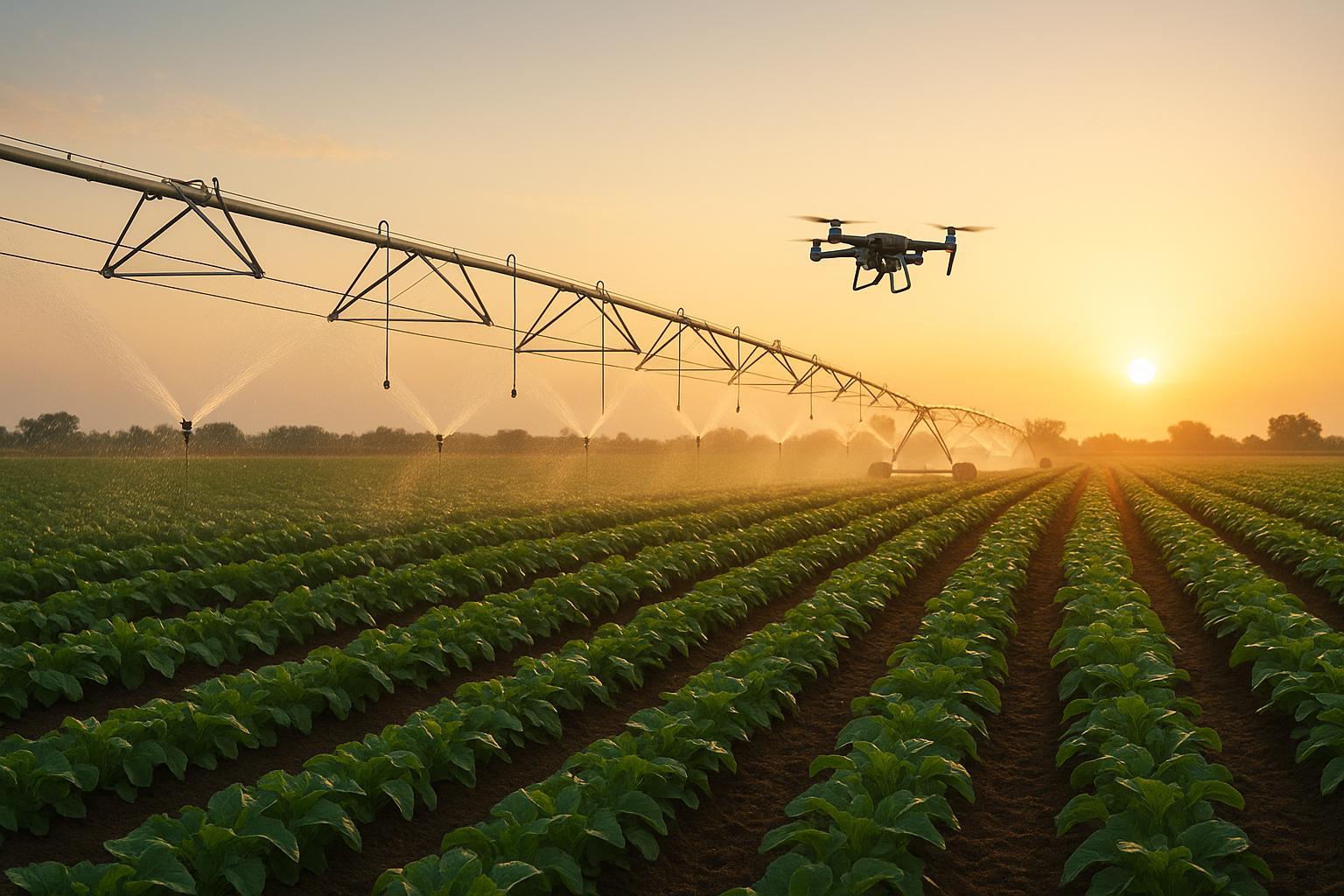
How AI Tracks Irrigation Performance in Real Time
Explore how AI-driven irrigation systems optimize water usage and enhance crop yields through real-time monitoring and predictive analytics.
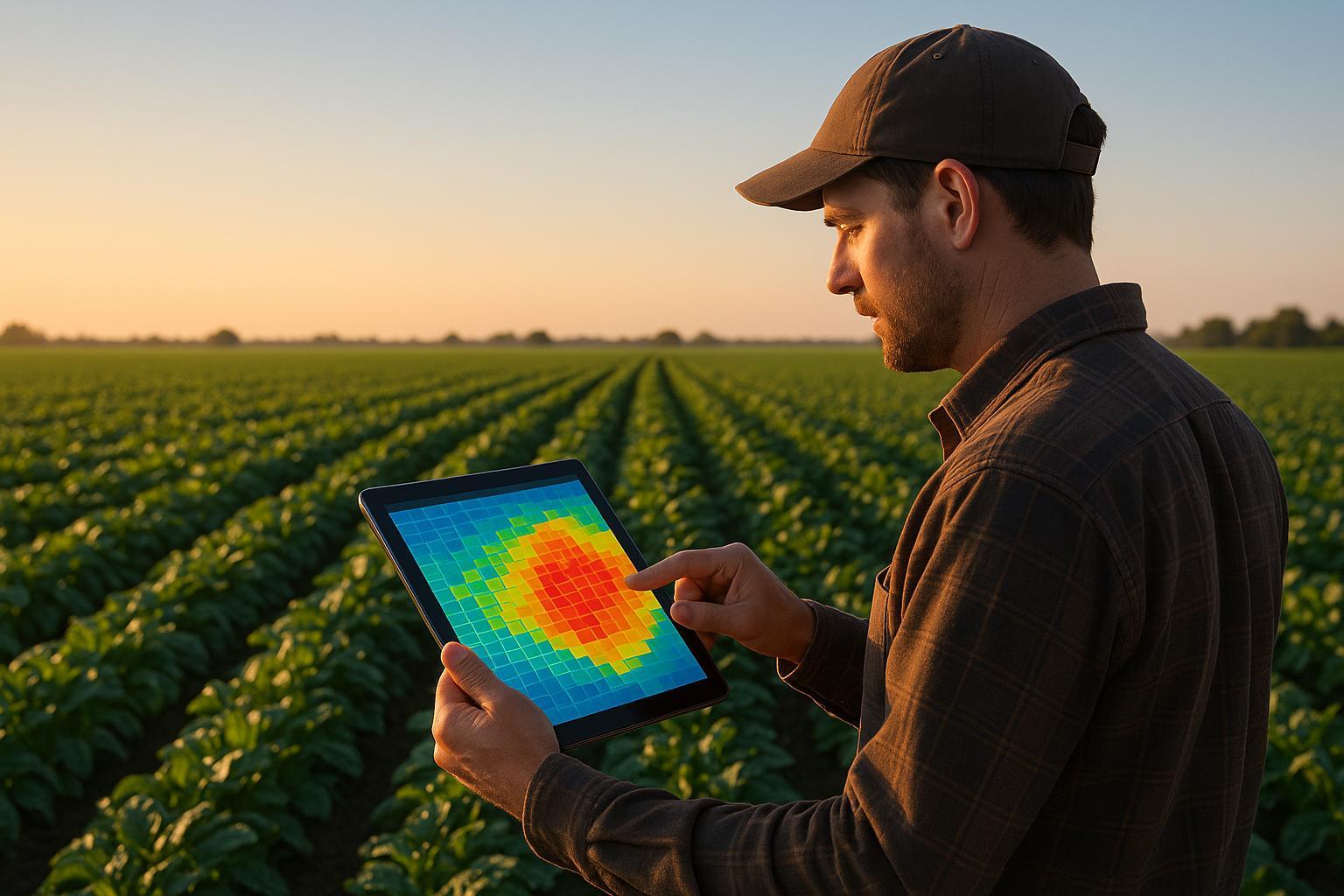
Growing Degree Days: AI's Role in Pest Control Timing
Explore how AI and Growing Degree Days enhance pest control timing, reducing pesticide use and increasing crop yields for sustainable agriculture.
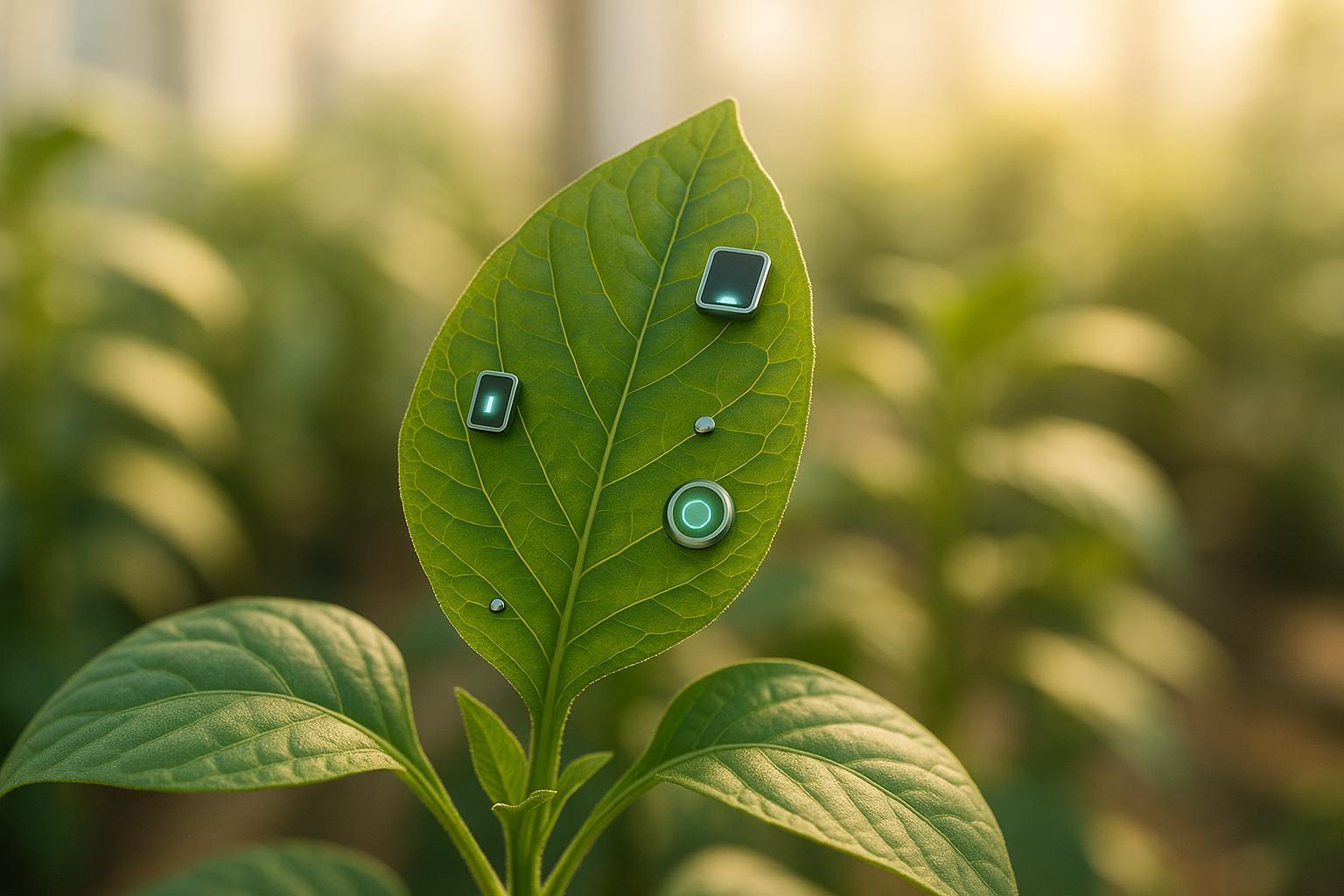
How Multi-Sensor Systems Detect Plant Diseases
Explore how multi-sensor systems revolutionize plant disease detection with advanced technology, offering early insights and precise treatment strategies.

Preserving Jalapeno Peppers: Methods and Tips
Discover the best techniques for preserving jalapeno peppers from your garden. Learn about canning, freezing, and drying methods to enjoy jalapenos year-round.